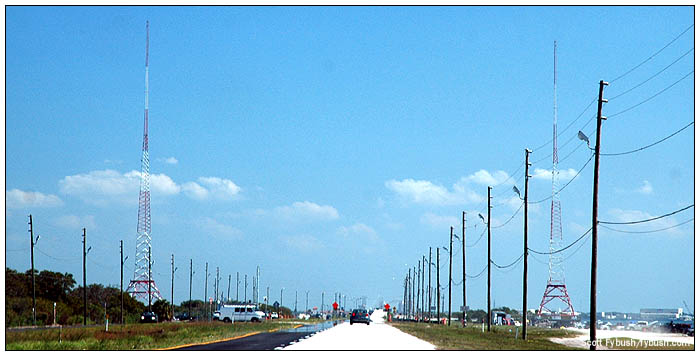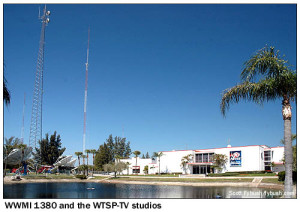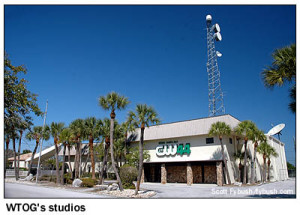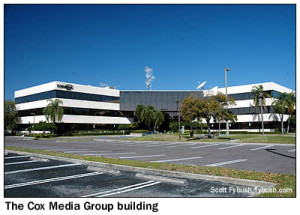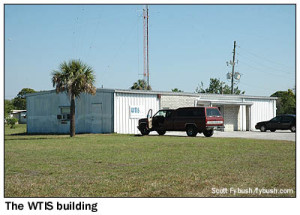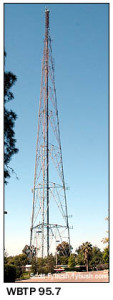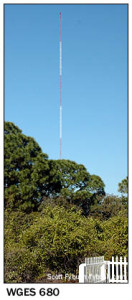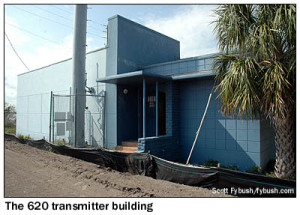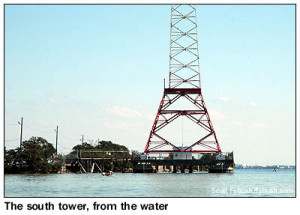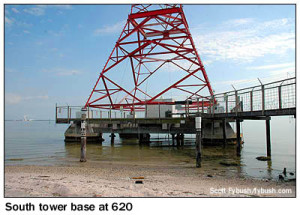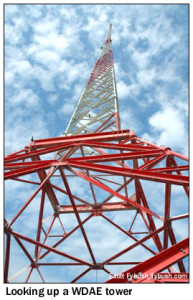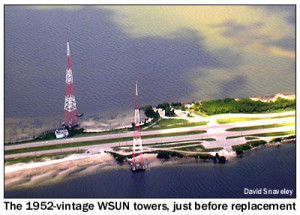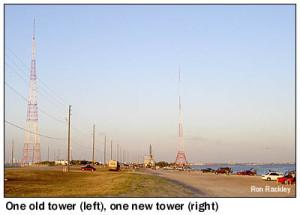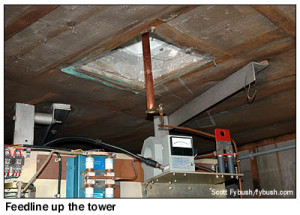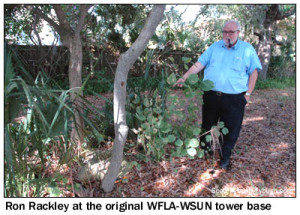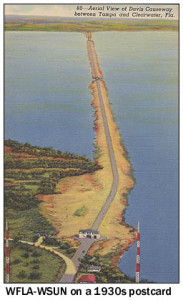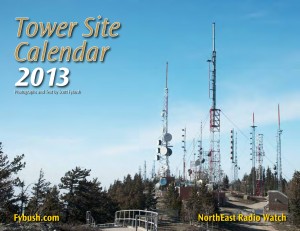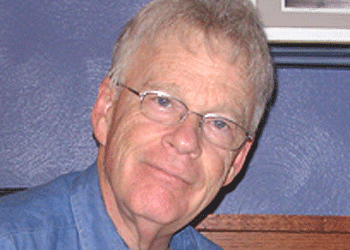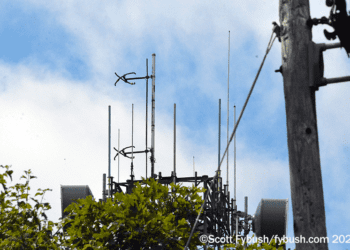Text and photos by SCOTT FYBUSH
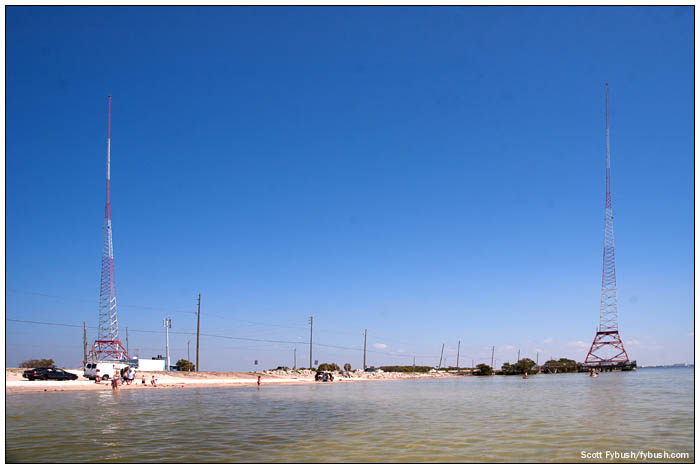
In this week’s installment of Tower Site of the Week (originally published October 14, 2011), we begin with the warm, sunny Florida image that greeted you at the start of Tower Site Calendar 2012: the two towers of WDAE (620 Tampa) straddling the Gandy Boulevard causeway that connects the north end of St. Petersburg to the south side of Tampa.

It’s not just a nice place to be in the winter (especially in the shallow water just off the south side of the highway, where we took the top photo), it’s also a spot with a lot of broadcast history and a lot of present-day broadcasting activity going on. Within a mile or two of the WDAE towers are two more AM sites, an FM and several studios, too – and in this week’s installment, we’ll look at all of them.
 The studios are all tightly clustered just off the west end of the causeway, where Gandy Boulevard meets Fourth Street North, one of the main drags coming north from St. Petersburg.
The studios are all tightly clustered just off the west end of the causeway, where Gandy Boulevard meets Fourth Street North, one of the main drags coming north from St. Petersburg.
From east to west, we start with the studios of the Tampa area’s CBS affiliate, Gannett-owned WTSP-TV (Channel 10), right on the north side of the Causeway as it makes landfall.
This is a station with an interesting history: the last VHF station to sign on in the Tampa Bay market, this was a late entry in the market, debuting in 1965 as ABC affiliate WLCY-TV. It was licensed to Largo, a few miles north of here, and transmitted from a tall tower in Holiday, considerably north of here in southern Pasco County, to avoid short-spacing to the existing channel 10 in Miami.
These studios on Gandy Boulevard (the “Rahall Color Communications Center”) opened in 1968, but WLCY already had a fairly extensive history at this site, which it had been using since 1949 as the transmitter and studio site of WLCY radio, at 1380 on the dial. The WTSP calls arrived in 1978, when WLCY(AM) and WLCY-FM (94.9) were sold off to separate owners; ironically, the WTSP callsign had been used in the early years of the AM station as well, back in the days when the station was owned by Nelson Poynter’s St. Petersburg Times.
The AM station went through a succession of owners, ending up a decade ago in Radio Disney’s hands. Today, it’s WWMI (“Mickey”), running 5000 watts day and night from the three towers next to the studios of the TV station. (We’ll visit its tower site up in Holiday in a couple of weeks, now that we’re finally back to the Tampa-St. Petersburg portion of our “Big Trip 2011” recap.)
 |
 |
Around the corner from WTSP and WWMI and a block or so north, we come to the corner of Oak Street and 105th Terrace NE, where we find what was once one of the most prominent independent stations in the southeast. WTOG (Channel 44) signed on in 1968 as a sister station to the legendary WGTO radio, which boasted a reach from the “Gulf to Okeechobee” at 540 on the dial from its home in Cypress Gardens. Under the ownership of Hubbard Broadcasting, WTOG did even better, with cable and translator carriage across much of central and northern Florida in the 1970s and 1980s before settling down in the 1990s as the local UPN (and later CW) outlet for Tampa Bay. (It ended up in the hands of Paramount as part of a trade to Hubbard for stations in Rochester and Albany; today WTOG is owned by CBS itself.)
 Continuing west on Gandy, the first major intersection is with Fourth Street North, and a short drive north on Fourth brings us to the big office-park building that’s home to Cox Media Group’s radio cluster of six FMs, all of which we’ll see in later installments of this Florida trip. (The photos you’re seeing here were taken on a Sunday, which is why we didn’t get a studio tour and why the parking lot is so empty!)
Continuing west on Gandy, the first major intersection is with Fourth Street North, and a short drive north on Fourth brings us to the big office-park building that’s home to Cox Media Group’s radio cluster of six FMs, all of which we’ll see in later installments of this Florida trip. (The photos you’re seeing here were taken on a Sunday, which is why we didn’t get a studio tour and why the parking lot is so empty!)
The Cox building is at the intersection of Fourth Street North and 112th Avenue NE, and 112th Avenue dead-ends at another AM site: the studio and transmitter of Tampa-licensed religious daytimer WTIS (1110). WTIS runs 10 kilowatts from three towers, and if you look very carefully at the photo below you can see the two smaller, unpainted towers to the left of the studio and the taller tower.
Returning to Gandy Causeway, we turn our attention to the south side of the road, where we find two more transmitter sites: Clear Channel’s WBTP (95.7 Clearwater) is on a fairly new 655-foot self-supporting tower tucked in amidst a somewhat seedy stretch of bars and restaurants along Gandy near the intersection with San Martin Boulevard, which winds its way south to Riviera Bay, one of the many little inlets from Tampa Bay along the shore here.
Along San Martin near the edge of Riviera Bay, we spot one more AM: Spanish-language WGES (680) runs 690 watts by day, 130 watts at night, non-directional from this stick near the corner of San Martin and Weedon Drive.
And having seen all of the other sites in the neighborhood, it’s now time for our main attraction: the fascinating two-tower array of WDAE (620), part of that exclusive club of AM stations with major roadways running through their directional arrays – and, so far as I know, the only member of the even more exclusive club of “AM stations now on their second sites with major roadways running through their directional arrays.”
 The history, then: the station now on 620 traces its heritage back to 1927, when WSUN signed on with 750 watts at 590 on the dial, taking on a separate identity from its share-time partner WFLA, which traced its own history to 1925 as a joint venture of the chambers of commerce of St. Petersburg and Clearwater. (After the split, Clearwater owned WFLA while St. Petersburg owned WSUN.)
The history, then: the station now on 620 traces its heritage back to 1927, when WSUN signed on with 750 watts at 590 on the dial, taking on a separate identity from its share-time partner WFLA, which traced its own history to 1925 as a joint venture of the chambers of commerce of St. Petersburg and Clearwater. (After the split, Clearwater owned WFLA while St. Petersburg owned WSUN.)
The shuffling of the AM dial in that era moved WFLA and WSUN to 580, then 900, and by 1929 they’d settled down on 620 – but after a power hike to a whopping 2000 watts day/1000 watts night, the FCC ordered a cutback to 500 watts day/250 watts night to protect an older station on the channel, WTMJ far to the north in Milwaukee.
To get past that obstacle, WFLA and WSUN did some innovating: in 1932, they began testing the first modern directional antenna (and some of the first vertical antennas) in the US, designed specifically to null the signal toward Milwaukee after dark while radiating plenty of signal toward Clearwater, St. Petersburg and Tampa. That first directional array straddled what’s now State Route 60, the Gulf-to-Bay Boulevard, at the west end of the Courtney Campbell Causeway near Bayview, near the northern end of Tampa Bay about seven miles northwest of the current site.
(Broadcast historian Jeff Miller has a fantastic summary of the early history of WFLA and WSUN here.)
That site – and we’ll see more about it momentarily – didn’t last long. By 1940, WSUN and WFLA had gone their separate ways, with WFLA (now owned by the Tampa Tribune) moving to 940 and then 970 and WSUN (now owned by the city of St. Petersburg itself) buying out the other half of the 620 facility. By 1952, the pioneering Bayview facility was history and WSUN was on the move again, building a pair of 500-foot Blaw-Knox self-supporting towers at its current site here astride Gandy Boulevard.
From this site, WSUN kept growing: it soon ran 5000 watts day and night on 620, directional only at night, with the waters of Tampa Bay providing a magnificent launching point for a monster low-on-the-dial signal covering much of Florida’s west coast. The towers were designed to hold more than just AM radio: the north tower, behind the transmitter building, was built to hold a TV antenna as well, and St. Petersburg officials soon put the market’s first TV station, WSUN-TV (Channel 38), on the air, initially from studios in this very building.
Unlike some other early UHF stations, WSUN-TV hung on (in part on the strength of having beaten its first two VHF competitors to the air by two years), becoming the market’s ABC affiliate until the debut of WLCY-TV just down the road in 1965 stripped it of that affiliation. After five years as a struggling independent, WSUN-TV succumbed in 1970 and the channel stayed vacant until the present-day WTTA signed on two decades later.
As for WSUN radio, the city of St. Petersburg sold it to a commercial operator in 1966, and after a few decades as a successful country station it began to slip into the AM abyss in the 1990s, running through a succession of owners that included CBS Radio and Taft and a succession of formats as well.
Under the calls WSAA, it was reduced to a simulcast of the Bay News 9 cable news operation (the WSUN calls ended up on a Cox FM signal where they still reside today) until new owner Jacor/Clear Channel once again took full advantage of the big 620 signal, relocating sports station WDAE from 1250 down to 620.
 (There’s a whole column’s worth of irony right there: WDAE was another very early Tampa station, and one of the late-1920s shuffles found WDAE vacating the 570 frequency to clear the way for WSUN to move there from 900; later on, WFLA, which had once shared 620 with WSUN, ended up diplexed on the Oldsmar transmitter site of 1250 WDAE, and eventually all three signals wound up in Clear Channel’s fold.)
(There’s a whole column’s worth of irony right there: WDAE was another very early Tampa station, and one of the late-1920s shuffles found WDAE vacating the 570 frequency to clear the way for WSUN to move there from 900; later on, WFLA, which had once shared 620 with WSUN, ended up diplexed on the Oldsmar transmitter site of 1250 WDAE, and eventually all three signals wound up in Clear Channel’s fold.)
Clear Channel put money into both the programming and the signal at 620: the sports format (“The Sports Animal”) benefited from the arrival of the Tampa Bay Rays, for which it has long served as flagship; it’s also home to the NHL Lightning and it’s the AM flagship for the Buccaneers. On the technical side, interference from Cuba led to a long-term STA that allows WDAE to run twice its licensed power – 10,000 watts until a few years ago, when the 1952 Blaw-Knox towers were removed and replaced with shorter new towers.
That project, too, is an article unto itself: six decades in the salt water had severely corroded the old towers; the towers couldn’t be rebuilt to the old design and still meet current building codes; but the old tower foundations had to stay in place to avoid all sorts of environmental and permitting issues, which is how they ended up with somewhat skinnier, shorter triangular cross-section new towers (375 feet each) atop the fatter, four-sided bases of the original towers on either side of Gandy. (The photo at right shows what it looks like from the base of the south tower, which is, I believe, the daytime non-directional tower as well; the photos below show the old towers before replacement and during the project, while the old north tower was still standing and the south tower had been replaced.)
 |
 |
The shorter towers made for a somewhat less-efficient antenna system (or, to put it a different way, the ability to use higher power on a regional channel allowed for the use of shorter towers), and so the station is now licensed for 5600 watts by day, 5500 watts at night, with the STA allowing for a doubling of power to 11.2 kW days, 11 kW nights.
 Inside the transmitter building on the north side of the highway (a bit difficult to access the day we visited, thanks to a road construction project), there’s little sign of the TV station that once operated here – just a big room with a Harris DX10 transmitter for aux use and, for the main, the only Harris DX15 we’ve ever seen. There’s also a lot of studio gear stored here, some of it from a rebuild of the Clear Channel studios (which we didn’t get to see) on the Tampa side of Gandy Boulevard, three miles or so east of here.
Inside the transmitter building on the north side of the highway (a bit difficult to access the day we visited, thanks to a road construction project), there’s little sign of the TV station that once operated here – just a big room with a Harris DX10 transmitter for aux use and, for the main, the only Harris DX15 we’ve ever seen. There’s also a lot of studio gear stored here, some of it from a rebuild of the Clear Channel studios (which we didn’t get to see) on the Tampa side of Gandy Boulevard, three miles or so east of here.
So that’s the current 620 site – but there’s still a bit of history to be uncovered here, and for that we turn to Ron Rackley of duTreil, Lundin and Rackley, one of the world’s preeminent authorities on AM directional antenna design and construction, the designer of the WDAE tower reconstruction project – and, as it happens, our most engaging lunch companion for one day of our Florida excursion this past March.
After a most interesting lunch in his home base of Sarasota, Ron suggested we head north to Bayview, where a few years ago he’d tracked down the spot where the original WSUN-WFLA directional array, granddaddy of them all, once sat. It’s not easy to pinpoint after 60 years – the original transmitter building and the site of the south tower were long since paved over for a widening of State Route 60.
But if you know what you’re looking for – and especially if you’re with Ron, bushwhacking his way into the trees, you can just make out the concrete base of one of the original tower legs, the last remaining relic of the nation’s first directional array.
Thanks to Clear Channel’s John McMartin for the site tour, and to Ron Rackley for the WFLA-WSUN discovery!
 It’s 2013! Do you have your Tower Site Calendar 2013 yet? We’ve still got some left, and they’re shipping right away from the all new Fybush.com store! Order now and your wall can be festooned with Florida and much more all through 2013. (We’ve also got the very last FM Atlas copies available for sale, and the new edition of the National Radio Club’s AM Log.)
It’s 2013! Do you have your Tower Site Calendar 2013 yet? We’ve still got some left, and they’re shipping right away from the all new Fybush.com store! Order now and your wall can be festooned with Florida and much more all through 2013. (We’ve also got the very last FM Atlas copies available for sale, and the new edition of the National Radio Club’s AM Log.)
Want access to more than a dozen years’ worth of Tower Site of the Week? All our archives, fully searchable, are available to Fybush.com subscribers – and you get full access to NorthEast Radio Watch, too! Subscriptions start at just $15. Sign up here!
And don’t miss a batch of Tampa Bay IDs next Wednesday, over at our sister site, TopHour.com!
Next week: Tampa, 2011 (part 2)


